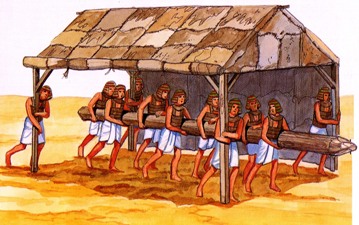
For much of Egypt's history, Egypt was not a war-like country. Early battles were mostly civil wars fought inside Egypt. The pharaohs, were more interested in protecting the wealth of the Nile Valley and Nile Delta rather than trying to gain power in the region.
The
weapons of war were also the tools of peace in many cases.
For example, a battle axe can also be used to cut wood. A bow and
arrow can be used for hunting animals for food as well as for killing enemies.

The Hyksos used horses and chariots which the Egyptians did not have at the time. The greater speed of the chariots made them a devastating weapon.
In time, the Egyptians learned to make and use chariots and were able to fight back.
Finally the armies and princes of Thebes (in the South of Egypt) repelled the Hyksos.
From then on, the Egyptians had a new spirit of aggression and determination. As a result, they created the greatest empire of its day. Conquering such an empire needed a large, full-time, well-trained army.
This army conquerered most of Egpyt's Eastern neighbours, such as the Canaanites and Syrians.

The army used long ladders to climb up the walls of the fort or enemy city in order to get inside. Some of the ladders even had wheels so that they could be pushed up to the walls more easily.
Another way the army would try to break in to a city or fort was to use a battering ram like this.

Egyptians fought many battles at sea such as the great victory over the Sea people in 1180 BC. The main reason that the
Egyptians won that battle was that their warships had both sails and oars, the sea peoples ships only had sails.
Did you know that the bronze lions head that was on the prows (bow)
of Ramesses III 's warship wasn't for decoration and was in fact used as a weapon, that rammed, holed and sanked enemy ships.
In 31 BC, the navy lost the battle which cost Queen Cleopatara VII her life and Egypt, her independence.
Did you know that the sailors didnt actually didn't do any fighting, in fact it was another group of men that did the fighting. They were known as the marines.
You can read more about the Egyptian navy on this page, which was made by high school students in Canada.

Very few peasants from Egypt ever left their home villages. The best way for a young man from say a small town in upper Egypt to see more of the country would be to volunteer for the army. Training was harsh, with new recruits having to march until they dropped.
Eventually they learned the basic skills of a soldier and were able to join an established army unit.
As well as volunteers, mercenaries were commonly used in the Egyptian army. Until about 1080 BC these were mostly from Nubia (to the South), and Libya (to the West) and Sardinia. After that date the army hired mostly Greeks.
Weapons
Usually soldiers would specialise in one or two of the many weapons in use at the time after they had mastered the use of the spear and bows and arrows.
Examples of other weapons include the battle-axe, Battle-Mace, the dagger, Khopesh (a type of sword) and sword.
The army officers carried batons and staffs. Although these were meant to be used to display the officer's rank, they could have been used to strike misbehaving or rude soldiers!
